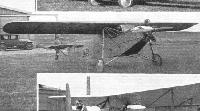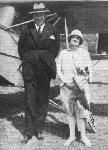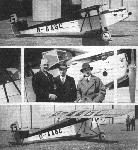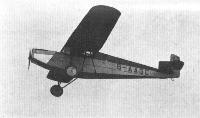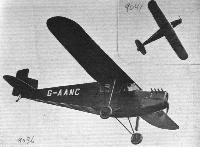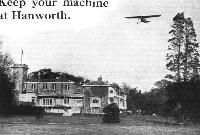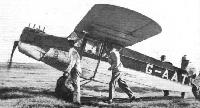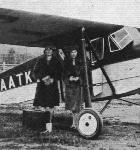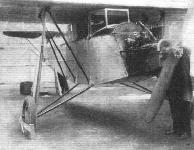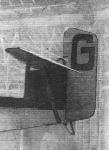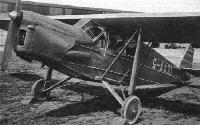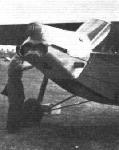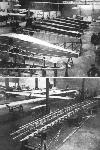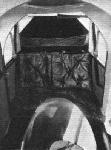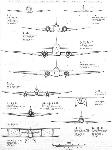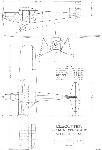
Описание
Страна : Нидерланды
Год : 1928
Трехместный спортивный/туристский моноплан с закрытой кабиной
Koolhoven FK 41
Ф. Кулховен спроектировал несколько не самых удачных самолетов, включая двухместный учебный полутораплан FK 32, трехмоторный FK 33 на девять пассажиров (использовался в компаниях "Lufthansa" и "German Aero"), трехместный гидроплан-разведчик FK 34 и двухместную ультралегкую машину FK 30 Toerist.
Следом был разработан трехместный спортивный высокоплан FK 41. Первый FK 41 поднялся в воздух в июле 1928 года. Самолет строился в Голландии серийно в двух вариантах: FK 41 Mk I с мотором Cirrus Hermes мощностью 105 л.с. и FK 41 Mk II с мотором de Havilland Gipsy мощностью 130 л.с.
Оба самолета в Великобритании выпускала по лицензии "Desoutter Aircraft Company", всего был построен 41 аппарат.
Позже FK 41 получил упрощенное хвостовое оперение. В годы войны самолеты голландской и британской постройки эксплуатировались в Австралии, Бельгийском Конго и в Южной Африке.
ТАКТИКО-ТЕХНИЧЕСКИЕ ХАРАКТЕРИСТИКИ
Koolhoven FK 41
Тип: трехместный спортивный/туристский моноплан с закрытой кабиной
Силовая установка: один мотор de Havilland Gipsy мощностью 130 л. с.
Летные характеристики: максимальная скорость 195 км/ч
Масса: максимальная взлетная 900 кг
Размеры: размах крыла 10,50 м; длина 7,80 м
Описание:
- Koolhoven FK 41
- Flight, April 1929
THE NEW DESOUTTER-CIRRUS MONOPLANE - Flight, May 1929
THE DESOUTTER THREE-SEATER MONOPLANE - Flight, June 1929
BRITISH AIRCRAFT AT OLYMPIA - Flight, April 1930
AIRCRAFT FOR THE PRIVATE OWNER - Flight, September 1930
Desoutter Mark II
Фотографии
-
Авиация и Космонавтика 2013-10 / В.Морозов - Великая воздушная гонка
Регистрационный номер: OY-DOO "Десоутер" Mk.II
-
Air Pictorial 1998-03
Регистрационный номер: G-AAPZ [3] After a rebuild which began in 1985 by members of the Shuttleworth Veteran Aeroplane Society, including Tony Dowson and Ken Hyde, the Collection’s Desoutter I monoplane made its first post-restoration flight on January 26, 1998.
-
Aeroplane Monthly 1993-12 / M.Oakey - Grapevine
Регистрационный номер: G-AAPZ [3] The Shuttleworth Collection’s Desoutter I G-AAPZ up on its wheels and tailskid on October 6, 1993. According to Ken Hyde, who is masterminding the project to put ’PZ back in the air, the last time the aircraft was in this condition was 1937!
-
Flight 1928-07 / Flight
Регистрационный номер: H-NAER [2] SOME AIRCRAFT TYPES AT THE ROTTERDAM MEETING: 3, the new Koolhoven monoplane, type F.K. 41. This is a three-seater touring machine.
-
Flight 1928-08 / Flight
Регистрационный номер: H-NAER [2] ECONOMICAL AVIATION: The Koolhoven F. H. 41, although fitted with a Siemens engine of 50 h.p. only, carries pilot and two passengers. The machine is built mainly of wood, both fuselage and wing being covered with three ply. On the right the machine is seen in flight, piloted by M. Van Vloten.
-
Flight 1929-07 / Flight
Регистрационный номер: PH-AER GETTING THEM DOWN AT WAALHAVEN: Various styles of landing over the tape are shown. 7. Koolhoven F.K.41.
-
Flight 1928-07 / Flight
"TINY AND TOT": Mr. and Mrs. F. Koolhoven, standing by the new F.K.41 monoplane.
-
Aeroplane Monthly 1977-01 / M.Langley - Fifty years in aviation
Регистрационный номер: G-AAGC [8] The Desoutter Monoplane was born in 1929, when Marcel Desoutter formed a company to manufacture the Koolhoven F.K.41 three-seater under licence. The second F.K.41, on the photo, was flown to Croydon and G. H. Handasyde revised the design. The Croydon-built examples, powered by Hermes I engines, were built in part of what was once the ADC factory.
-
Flight 1929-04 / Flight
Регистрационный номер: G-AAGC [8] -
Flight 1929-09 / Flight
Регистрационный номер: G-AAGC [8] PART OF THE N.F.S. FLEET: Mr. Marcel Desoutter by the tail of his first machine discusses the Martlet with a friend.
-
Flight 1929-05 / Flight
Регистрационный номер: G-AAGC [8] -
Flight 1929-07 / Flight
Регистрационный номер: G-AAGC [8] LATEST DESOUTTER MONOPLANE: The "D.A.C. Sports Coupe" (Cirrus III).
-
Flight 1929-07 / Flight Advertisements
Регистрационный номер: G-AAGC [8] -
Aeroplane Monthly 1990-05 / J.Stroud - Wings of Peace
Регистрационный номер: G-AAGC [8] Two views of the second Koolhoven FK 41. These views show many of the features which were common to the single-engined Koolhoven high-wing monoplanes.
-
Flight 1930-06 / Flight
Регистрационный номер: G-AANC FINISHED FLYING: Flight-Lieut. Schofield's demonstrations of aerobatic flying are always characterised by a remarkable "finish." He is here seen flying the Desoutter-Hermes monoplane, and, inset, flying upside down.
The NFS Desoutters were used for taxi work, here Flt Lt Schofield brings in G-AANC at Woodley on Whit Monday, 9.6.30. -
Flight 1931-02 / Flight
Регистрационный номер: G-AAND ABOVE WINDSOR CASTLE: A remarkable view of the Castle with the River Thames in the background. The machine is a Hermes-engined Desoutter belonging to National Flying Services.
-
Aeroplane Monthly 1976-12 / B.Williams - On tour with Cobham's Circus
Регистрационный номер: G-AANE Desoutter I G-AANE, flown by Tommy Nash for joy riding, was owned by Rollason Aircraft Services Ltd based at Croydon.
-
Flight 1929-11 / Flight
Регистрационный номер: G-AAPK Above are the new workshops which will cater for the needs of the whole of the N.F.S. organisation. Below, two passengers about to "enplane" in one of the new Desoutter cabin machines (with Cirrus "Hermes" engines), which N.F.S. have standardised on their taxi-service.
-
Flight 1929-12 / Flight Advertisements
One of the "taxis" returning home. A Desoutter - Hermes over Hanworth.
-
Flight 1932-01 / Flight
Регистрационный номер: G-AAPP [2] THE "SPARTAN CIRCUS" IN AFRICA: "Snap" from the Cape taken on the occasion when the Circus (which is composed of Mr. Oscar Garden, Capts. E. D. Ayre, J. King, E. D. Cummings, Mr. John Tranum and Mr. C. E. F. Reilly) now touring Africa, visited the Cape Town Airport. Capt. King giving joy-rides in the Desoutter
-
Flight 1929-12 / Flight
Регистрационный номер: G-AAPP [2] A Hermes-Desoutter Coupe at Hanworth. In front are Capts. Stack, Rodney, Schofleld and Styran of N.F.S.
-
Flight 1930-02 / Flight
Регистрационный номер: G-AAPY The "Daily Mail" having had a run of bad luck with "Geraldine" have now purchased a Desoutter; no doubt they will be happier with their latest love!
-
Flight 1930-04 / Flight
Регистрационный номер: G-AATI -
Flight 1930-09 / Flight
A PREVIOUS AUSTRALIAN FLIGHT: This illustration may be of interest just now, for it shows the first cabin monoplane to make a flight from England to Australia - the Desoutter ("Cirrus-Hermes") of Flying Officers Piper and Kay, taken on their arrival at Mascot Aerodrome on April 3 last.
-
Flight 1930-06 / Flight
Регистрационный номер: G-AATK Miss Winifred Spooner with Lady Currie just before their trip to Paris in the Hermes-Desoutter.
-
Aeroplane Monthly 1989-01 / Personal album. Civil
Регистрационный номер: G-AATX Desoutter I G-AATX in the orange and black colours of National Flying Services Ltd, probably snapped at Hanworth. The aircraft was destroyed in a crash at Edenbridge, Kent on October 1, 1932 whilst owned by Maidstone Airport Ltd.
-
Aeroplane Monthly 1981-07 / Whitchurch /Gone but not forgotten/ (10)
Регистрационный номер: G-AAVO [2] Early resident at Whitchurch was Desoutter II G-AAVO.
-
Flight 1932-06 / Flight
Регистрационный номер: G-AAVO [2] The Phillips & Powis "Desoutter" (Hermes) piloted by Mr. S. Cliff winning by a short head from Mr. Norman Edgar in the "Elf" (Hermes).
Другие самолёты на фотографии: Parnall Elf - Великобритания - 1929
-
Flight 1930-05 / Flight
Регистрационный номер: G-AAWT [2] COMMERCIAL ENTERPRISE: The Desoutter (Hermes) recently delivered to Cirrus Engines, Ltd. This will enable Mr. V. Holman, sales manager, to keep in better touch with all the firm's customers. Mr. V. Holman, who is an experienced pilot, will fly the machine himself.
-
Air-Britain Archive 1982-03
Регистрационный номер: G-AAWT [2] Very much a where and when problem. Desoutter G-AAWT was sold to the Dutch East Indies in 10.33 then regd PK-SAN to a Surabayan company 27.12.33. DH.60M PK-SAF was based at Surabaya from 3.8.33, as was Pander EG-100 PK-SAJ from 6.2.33. It would seem that the photo must have been taken in late 1933 at Surabaya, NEI. (Credit H.Hazewinkel in Digest Nov/Dec 1978) The KNILM Fokker F.VIIB may be PK-AFG from evidence on the original print.
Harm Hazewinkel informs us that Desoutter G-AAWT arrived at Surabaya 11.33 and was assembled at Morokrembangan Naval Air Base - which may be where the photo was taken although the KNILM Fokker would be more likely to be found at the civil airfield at Darmo.Другие самолёты на фотографии: De Havilland Gipsy Moth / Moth X - Великобритания - 1928Fokker F.VII / C-2 / F.XIV - Нидерланды - 1924Pander E - Нидерланды - 1926
-
Aeroplane Monthly 1991-02 / Personal album. Civil
Регистрационный номер: G-AAZI [10] Prototype Desoutter II G-AAZI photographed at Doncaster on May 26, 1935. Owned by Warden Aviation, G-AAZI was impressed into the RAF as HM507 in November 1941 and flew for a while as a communications hack with Percival Aircraft. After service elsewhere it was dismantled in July 1944 and burnt at the end of 1945.
-
Flight 1931-06 / Flight
Регистрационный номер: G-ABMW [3] FIRST BRITISH "AVION SANITAIRE": A Desoutter monoplane (Hermes) has been fitted up as a Red Cross machine.
-
Aeroplane Monthly 1990-05 / J.Stroud - Wings of Peace
Регистрационный номер: G-ABMW [3] The Red Cross Desoutter I after passing to Imperial Airways. It is seen at Croydon.
-
Air Pictorial 1956-10 / Photos by request
Регистрационный номер: VH-ULX KOOLHOVEN F.K.41 was a three-seater produced in the Netherlands in the late 1920s; also built in the U.K. (about forty) by the Desoutter Company. Normal engine was the Cirrus Hermes I, but VH-ULX (c/ n. 4103, crashed 10th November 1937, Condobolin, N.S.W.) was powered by a 90-h.p. D.H . Gipsy II. Two F.K.41s were on the British Register : G-AAGC and G-AALI (c/ n. not known). Former sold to S. Africa ; latter "sold abroad " (October 1929) may have become VH-ULX.
-
Air-Britain Archive 1981-03
Регистрационный номер: ZK-ACJ Desoutter I ZK-ACJ in original Hermes-powered form sometime during the 1930s.
-
Flight 1930-05 / Flight
COMMERCIAL PRODUCTION: A batch of Desoutter cabin aircraft ready for delivery at Croydon.
-
Flight 1933-07 / Flight
THE FINAL: Our veteran timekeeper, Mr. George Reynolds (right), starting the first man.
-
Flight 1929-11 / Flight
THE ILLUSTRATED PRESS GO FLYING: Our picture shows, from left to right, Mr. A. S. Frene and Capt. Alan Bott (of the "Graphic"), Mr. and Mrs. De Groot (Editor of the "Bystander"), at the Desoutter Sports Coupe demonstration at Hanworth.
-
Flight 1933-08 / Flight
The Mayor and Mayoress of Hull being greeted by Mr. F. P. Morgan, Chairman of the Club Committee, on their arrival in an N.F.S. Desoutter from the Hull Aero Club.
-
Flight 1930-06 / Flight
MUNICIPAL INTEREST: The Lord Mayor of Nottingham (Coun. W. Wesson), centre, about to go for a flight in the Desoutter-Hermes limousine piloted by Flight-Lieut. Schofield, right; Mr. Hooley (Sheriff) is on the left.
-
Flight 1933-07 / Flight
A WORTHY LOSER: Capt. E. D. Ayre, who missed getting his three-year-old Desoutter ("Hermes II") into the final three by only 7 sec, is here seen talking to a timekeeper before starting on the final.
-
Flight 1933-10 / Flight
A view (left) of the Hanworth cowling on one of the N.F.S. Desoutters ("Gipsy II"). This new clean design was made by the N.F.S. repair shops at Hanworth Park. On the right is shown another alteration to the N.F.S. Desoutter - the fitting of sliding windows to the passengers' cabin. These can be kept open in flight without undue draught entering the cabin.
-
Flight 1929-07 / Flight
The Desoutter Sports Coupe. With accommodation for pilot and two passengers this type should be very useful for taxi work, etc.
-
Flight 1929-05 / Flight
THE DESOUTTER MONOPLANE: The photograph gives a good idea of the low position of the engine above the ground, which facilitates inspection and adjustments.
-
Flight 1929-05 / Flight
THE DESOUTTER MONOPLANE: The somewhat unusual tail layout is shown.
-
Flight 1930-07 / Flight
Регистрационный номер: G-AAZI [10] THIS is a recent development of the Mark I machine, and among the changes may be noted the fitting of an inverted engine (Gipsy III), which has improved the view.
-
Flight 1930-10 / Flight
Регистрационный номер: G-AAZI [10] Cabin machines suitable for the private owner: the Desoutter (Gipsy II).
-
Aeroplane Monthly 1977-01 / M.Langley - Fifty years in aviation
Регистрационный номер: G-AAZI [10] A grand total of 28 Desoutter Is were built, plus 13 examples of the Gipsy-engined Desoutter II of 1930. The first of the latter was G-AAZl, which first flew in 1930, survived wartime impressment as HM507, but was scrapped and burned in December 1945.
-
Aeroplane Monthly 1977-01 / M.Langley - Fifty years in aviation
The picture shows a Desoutter Monoplane over Croydon in the 1930s.
-
Flight 1930-06 / Flight
Регистрационный номер: G-AAZI [10] THE NEW DESOUTTER MONOPLANE: The Mark II, with Gipsy III engine, has now been flown at Croydon, and appears to come well up to expectations. The clean nose produced by the inverted engine adds greatly to the appearance of the machine, as does also the new style of tail and slightly shallower fuselage. The new machine is likely to become very popular at the price for which it is to be marketed.
-
Flight 1930-09 / Flight
Регистрационный номер: G-AAZI [10] THE DESOUTTER MARK II: Three-quarter Front View.
-
Flight 1930-09 / Flight
Регистрационный номер: G-AAZI [10] THE DESOUTTER, MARK II: Three-quarter rear view.
-
Aeroplane Monthly 1996-07 / G.Copeman - A backward glance
Регистрационный номер: G-AAZI [10] G-AAZI was one of several Desoutters owned by Richard Shuttleworth. This Desoutter II was built with a Gipsy III engine and was acquired by R.O.S. in 1938.
-
Flight 1930-09 / Flight
Регистрационный номер: G-AAZI [10] VIEW: This illustration of the nose of the Desoutter Mark II, indicates the excellent view obtained by the pilot in the latest model. The engine is a Gipsy III.
-
Air Enthusiast 2000-11 / G.Warner - Founding Fathers (2)
Регистрационный номер: EI-AAD The first commercial aircraft to be registered in Ireland was this Desoutter II EI-AAD in August 1930.
-
Мировая Авиация 166
Регистрационный номер: PH-AJZ Несмотря на "гражданское" происхождение, пять Desoutter Mk I и Mk II британской постройки поступили на вооружение Королевских ВВС. Один из них ныне находится в летном состоянии и принадлежит коллекции Шаттлуорта.
-
Flight 1932-01 / Flight
AN INDIAN PRIVATE OWNER: Rai Sahib Gopaldas, W.L.C., Secretary of the Nationalist Reform Party in the Punjab Legislative Council, and his Desoutter monoplane. He is the first private owner in the Punjab Province.
-
Flight 1931-01 / Flight
SOME PERSONAL FLYING SERVICES PERSONALITIES: Our picture shows Maj. I. N. G. Clarke (Chief Pilot), Capt. A. J. Styran (Pilot), and F. A. MaCoiser (Chief Engineer) of Personal Flying Services, Ltd., standing in front of three types of machines used by this air taxi company. These are a Desoutter, a Sikorsky S. 39 Amphibian, and a Junkers F.13 L monoplane.
Другие самолёты на фотографии: Junkers F 13 - Германия - 1919Sikorsky S-39 - США - 1929
-
Flight 1930-09 / Flight
BEDFORD: The line up of demonstration machines, showing Metal Moth (Gipsy I), Puss Moth (Gipsy III). Desoutter II (Gipsy III), Moth (Cirrus III), Avian (Hermes), Autogiro (Genet Major).
Другие самолёты на фотографии: Avro Avian / Type 594/616 - Великобритания - 1926Cierva/Avro C.19 - Великобритания - 1929De Havilland Gipsy Moth / Moth X - Великобритания - 1928De Havilland Puss Moth / D.H.80 - Великобритания - 1929
-
Flight 1930-09 / Flight
THE NEW TAIL: The photograph shows the tail of the Desoutter Mark II.
-
Air-Britain Archive 1980-03
Регистрационный номер: G-ABRN Sports Avian G-ABED "Jerry" pushed out at Woodford by Winifred Brown with Red Cross Desoutter G-ABRN of 19 31 behind.
Другие самолёты на фотографии: Avro Avian / Type 594/616 - Великобритания - 1926
-
Flight 1930-07 / Flight
The new Desoutter II. Our view shows the large doors on each side.
-
Flight 1935-09 / Flight
TRYING IT ON THE DESOUTTER. This is the brand new inverted six-cylinder "V" Monarch engine installed in a modified Desoutter for test purposes. The engine, which will be developed by Aero Engines Ltd., delivers 150 h.p. and weighs about 340 lb.
-
Aeroplane Monthly 1976-12 / B.Williams - On tour with Cobham's Circus
The circus comes to yet another town. In this formation, led by H.P. W.10 G-ABMR, are two Gipsy Moths, Comper Swift, Desoutter, Tiger Moth, Airspeed Ferry and a Southern Martlet.
Другие самолёты на фотографии: Airspeed Ferry / AS.4 - Великобритания - 1932Comper Swift / CLA.7 - Великобритания - 1930De Havilland Gipsy Moth / Moth X - Великобритания - 1928De Havilland Tiger Moth / D.H.82 - Великобритания - 1931Handley Page H.P.18 (W.8) / H.P.30 (W.10) - Великобритания - 1919Southern Martlet - Великобритания - 1929
-
Aeroplane Monthly 1986-02 / H.Morris - The Barnstormer's Apprentice (4)
Alan Cobham's National Aviation Day display team hits town, led by an Airspeed Ferry flanked by Tiger Moths, Desoutters, a Gipsy Moth and an Avro 504K.
Другие самолёты на фотографии: Airspeed Ferry / AS.4 - Великобритания - 1932Avro Avro 504 - Великобритания - 1913De Havilland Gipsy Moth / Moth X - Великобритания - 1928De Havilland Tiger Moth / D.H.82 - Великобритания - 1931
-
Aeroplane Monthly 1985-12 / J.Stroud - Wings of Peace
Регистрационный номер: G-ABMW [3] Imperial Airways’ charter fleet line-up at Croydon in 1933. Right to left: Westland Wessex G-ACHI and G-AAGW, Avro Ten G-ABLU Apollo, and Desoutter I ambulance G-ABMW Air Taxi No.6.
Другие самолёты на фотографии: Avro Ten / Type 618 - Великобритания - 1928Westland Wessex / Westland IV - Великобритания - 1929
-
Air Enthusiast 1994-12 / M.Lowe - Island Hopper
G-ABLI in varied company. Note the single porthole behind the pilot’s cabin - was this prior to the Karachi flight or afterwards? Recognisable among the aircraft in the photograph are Cierva C24 G-ABLM (withdrawn from use December 1934); Puss Moth; Dessoutter (either G-ABFO or G-ABRN); Hendy 302 G-AAVT; Junkers F.13ge G-ABDC (sold in Sweden December 1934) and Comper Swift G-ABPE. Can anyone name and date the occasion?
Другие самолёты на фотографии: Cierva/De Havilland C.24 - Великобритания - 1931Comper Swift / CLA.7 - Великобритания - 1930De Havilland Puss Moth / D.H.80 - Великобритания - 1929Hendy Hendy 302 - Великобритания - 1929Junkers F 13 - Германия - 1919Spartan Cruiser - Великобритания - 1932
-
Авиация и Космонавтика 2013-10 / В.Морозов - Великая воздушная гонка
Датчане Хансен (справа) и Йенсен позируют у своего "Десоутера". Они прибудут к финишу восьмыми через одиннадцать дней
-
Flight 1929-11 / Flight
THE DESOUTTER FACTORY AT CROYDON: Some of the Machines nearing completion.
-
Flight 1929-11 / Flight
THE DESOUTTER FACTORY AT CROYDON: Top, the fuselage assembly line. Below, a Corner of the Plane Shop
A corner of the Desoutter works in October 1929, with two completed Desoutters, G-AAPP and G-AAPR, in the background. -
Flight 1930-09 / Flight
A VERY COMFORTABLE CABIN: The latest Desoutter, Mark II, has been designed with a view to giving real comfort to the occupants. The pilot's cockpit is roomy and the windows and large windscreen give an excellent view in all essential directions.
-
Flight 1929-07 / Flight
The Desoutter Sports coupe has seating accommodation for pilot and two passengers. Although simply a "deck chair" type, the passengers' seat is one of the most comfortable in the whole Show.
-
Flight 1930-09 / Flight
The slightly staggered seats for two passengers are well placed to avoid fatigue, and air cushions help to make a flight of even very long duration less tiring than a train journey.
-
Flight 1929-05 / Flight
THE DESOUTTER MONOPLANE: Some constructional details. The tubular engine mounting is shown in 1. Note the rubber pads interposed between the engine bearers and the feet of the engine to reduce vibration. A flexible (rubber) connection is made between the aileron crank and its operating tube, as shown in 2. The tail plane adjustment is shown in 3, and the elevator crank in 4. Fig. 5 illustrates the fitting which locates the wing in relation to the fuselage, but which permits deflection of the wing spar. The attachment of lift strut to rear spar is shown in 6.
-
Flight 1930-09 / Flight
THE DESOUTTER MARK II: On the left the very simple engine mounting, of welded steel tube, and on the right details of the manner in which the wing is located on the fuselage.
-
Flight 1930-09 / Flight
THE NEW TAIL: On left, the tail incidence adjustment, and, on the right, the bent crank which operates the elevator.
-
Flight 1930-09 / Flight
The ailerons are operated from the joy stick by a vertical tube and a crank on the spar. The crank, and its inspection door, is shown on the left. On the right, details of lift strut attachment to spar.
-
Flight 1934-10 / Flight
Другие самолёты на фотографии: Airspeed Courier / AS.5 - Великобритания - 1933Airspeed Envoy / AS.6 - Великобритания - 1934Boeing Model 247 - США - 1933Douglas DC-1 / DC-2 / C-32 / C-39 - США - 1933Fairey Fairey IIIF - Великобритания - 1926Lockheed Orion 9 - США - 1931Messerschmitt Bf.108 Taifun - Германия - 1934Miles Hawk / M.2 - Великобритания - 1932Pander S-4 Postjager - Нидерланды - 1933
-
Flight 1929-05 / Flight
Desoutter 3 Seater Monoplane Cirrus III Engine
-
Flight 1929-07 / Flight
D.A.C. Sports Coupe A.D.C. "Cirrus III" Engine
-
Flight 1930-09 / Flight
Desoutter Mk.II Gipsy III Engine
- Фотографии



